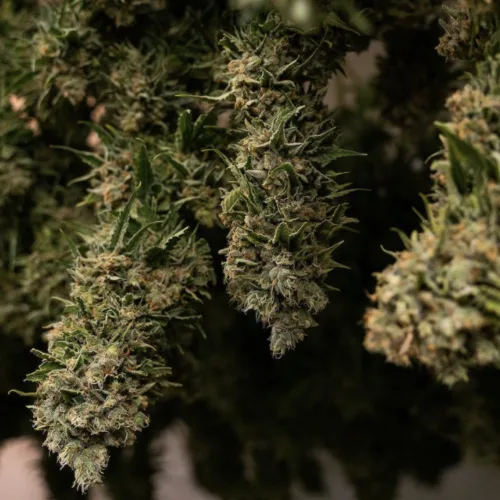Pain is a problem for most at one time or another and to varying degrees. The Center for Disease Control and Prevention (CDC) states that in 2019 20.4% of adults had chronic pain. And 7.4% of adults had chronic pain that limited life or work activities. That is a lot of pain. Every day people stay home from work miss school go to the doctor or even die because of the effects of pain. Whether from a hard workout a physically demanding lifestyle an illness a chronic condition or general discomfort pain can do more than just make you uncomfortable. For many people cannabis for pain is steadily gaining popularity as a natural approach to relief.
76 Million Americans Suffer from Pain We’re seeing just how severe the pain problem really is. Respondents to a 2018 National Health Interview Survey reported the most common pain locations were back pain and hip knee or foot pain. Findings indicated that more than 1 in 5 adults in the United States experience chronic pain. According to the American Pain Foundation more than a quarter of Americans (26%) aged 20 years and over — or an estimated 76.5 million Americans — reported a problem with pain of any sort that persisted for more than 24 hours.
- 50% of adults claim to suffer from chronic headaches.
- Chronic pain and depression statistics reveal that 85 percent of people suffer from depression as a result of feeling constant pain.
- 78 percent of emergency room visits are related to pain complaints.
- The four most common types of pain include low back pain (28%), knee pain (19%), headache (16%), and neck pain (15%).
- 1 in 5 American adults (or 42 million people) report that pain or physical discomfort disrupts their sleep three or more nights a week.
The CDC estimates the total U.S. economic burden of pain prescription opioid misuse is $78.5 billion a year. This includes the costs of health care lost productivity addiction treatment and criminal justice involvement. Some of these prescriptions may be warranted but with states like Massachusetts legalizing the use of both medical and recreational marijuana consumers in pain now have options.
Do People Use Cannabis for Pain? Cannabis has been a natural pain remedy for centuries long before there was any scientific research to prove its effectiveness. The first recorded medicinal use was in China circa 2900 B.C. and again in India in 1000 B.C. Cannabis eventually arrived in the west where its benefits are only now being seriously explored. According to a 2021 Harris Poll on chronic pain twice as many Americans are using CBD or marijuana for pain than opioid medication. Cannabis for pain is the second most-prevalent pharmacological pain solution following traditional over-the-counter pain medication. But just because a lot of people use cannabis doesn’t mean it always works. A 2017 Journal of Health Affairs survey on the effectiveness of cannabis for pain found that 84.6% of respondents found symptomatic relief for “evidence-based conditions.” 62.2% of respondents reported using marijuana for chronic pain.
How Cannabis Works for Pain We all have an endocannabinoid system (ECS). “Endo” means inside and “cannabinoids” are cannabis compounds. We have cannabinoids already inside of us that our body naturally produces. And we have receptors for the cannabinoids to interact with. This system helps the body establish and maintain balance for optimal health and wellness. The components of the ECS are expressed throughout the pain processing pathways. Cannabinoids like THC may enhance the efficacy of this system. Here’s a little more information about how cannabis works for pain.
Anti-Inflammatory Properties
Inflammation typically causes pain because the swelling and buildup of tissue start pressing against nerve endings. This pressure sends pain signals to the brain causing discomfort. Inflammation is a large component of most pain. Evidence indicates that cannabinoids may contribute to pain relief through anti-inflammatory properties. Other components of the cannabis plant such as terpenes and flavonoids may also contribute to the anti-inflammatory effects of cannabis.
Mood Boost and Less Pain
Anandamide is an endocannabinoid commonly referred to as the “bliss molecule” because of the way it makes you feel. It’s notably found in chocolate which may be one of the reasons chocolate is such a comfort food when we’re feeling down. Fatty Acid Amide Hydrolase (FAAH) is the enzyme that breaks down anandamide. Some cannabinoids inhibit the FAAH enzyme. As a result the breakdown of anandamide occurs slowly. This increases the levels of anandamide in the body allowing the body to relax and experience less pain.
Communication is Key One quality that sets cannabinoid receptors apart from other receptors in the body is their ability to conduct retrograde neuron signaling. That sounds pretty technical but stay with us. Typically one neuron sends a signal to another with information but no information is returned. Anandamide is a retrograde messenger which means that it can invoke a two-way (retrograde) communication system. The increased communication allows cells to receive information and respond according to signals received in the brain to promote balance. This includes pain signals.
